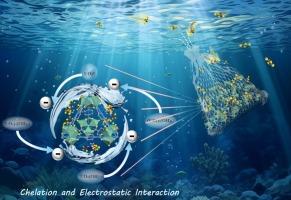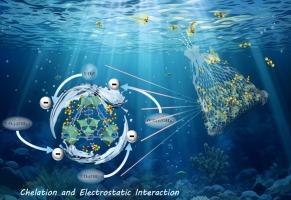草甘膦功能化MIL-101(Cr) -NH2在海水中超快提铀中的应用
IF 9
1区 工程技术
Q1 ENGINEERING, CHEMICAL
引用次数: 0
摘要
先进的金属有机骨架(MOF)吸附剂为从海水中快速高效地提取铀提供了重要的前景。MIL-101(Cr)以其大表面积、可调孔隙率和高稳定性而闻名,作为一种有前途的材料而引起了人们的广泛关注。本文合成了4种MIL-101(Cr)基吸附剂,并将其应用于U(VI)的吸附。其中,以草甘膦为共价接枝改性的MIL-101-BPMG表现出较好的性能。利用特定的螯合作用和静电相互作用,MIL-101-BPMG获得了719.6 mg/g的U(VI)吸附量,并在3 min内去除94 %的U(VI),明显优于同类材料。在6次吸附-解吸循环后,其离子选择性良好,U/V分离系数为8.1,去除率为87.2 %。此外,在加峰模拟和自然海水条件下,U(VI)的去除率分别高达68.4% %和49.35 %。这些发现表明MIL-101-BPMG具有结构稳定、容量大、动力学快、选择性强和可重复使用性好等优点,是实用海水提铀的理想候选物。本文章由计算机程序翻译,如有差异,请以英文原文为准。


Glyphosine-Functionalized MIL-101(Cr)–NH2 for ultrafast uranium extraction from seawater
Advanced metal–organic framework (MOF)-based adsorbents offer significant promise for the rapid and efficient extraction of uranium from seawater. MIL-101(Cr), known for its large surface area, tunable porosity, and high stability, has attracted significant attention as a promising material for this purpose. In this work, four MIL-101(Cr)-based adsorbents were synthesized and applied to the adsorption of U(VI). Among them, MIL-101-BPMG, functionalized with glyphosine via covalent grafting, exhibited superior performance. Leveraging specific chelation and electrostatic interactions, MIL-101-BPMG achieved a remarkable U(VI) adsorption capacity of 719.6 mg/g and removed 94 % of U(VI) within 3 min, markedly outperforming comparable materials. It also demonstrated excellent ion selectivity, with a U/V separation factor of 8.1, and maintained 87.2 % removal efficiency after six adsorption–desorption cycles. Moreover, U(VI) removal efficiencies remained as high as 68.4 % and 49.35 % under spiked simulated and natural seawater conditions, respectively. These findings highlight MIL-101-BPMG as a promising candidate for practical seawater uranium extraction, combining structural stability, high capacity, rapid kinetics, strong selectivity, and good reusability.
求助全文
通过发布文献求助,成功后即可免费获取论文全文。
去求助
来源期刊

Separation and Purification Technology
工程技术-工程:化工
CiteScore
14.00
自引率
12.80%
发文量
2347
审稿时长
43 days
期刊介绍:
Separation and Purification Technology is a premier journal committed to sharing innovative methods for separation and purification in chemical and environmental engineering, encompassing both homogeneous solutions and heterogeneous mixtures. Our scope includes the separation and/or purification of liquids, vapors, and gases, as well as carbon capture and separation techniques. However, it's important to note that methods solely intended for analytical purposes are not within the scope of the journal. Additionally, disciplines such as soil science, polymer science, and metallurgy fall outside the purview of Separation and Purification Technology. Join us in advancing the field of separation and purification methods for sustainable solutions in chemical and environmental engineering.
 求助内容:
求助内容: 应助结果提醒方式:
应助结果提醒方式:


